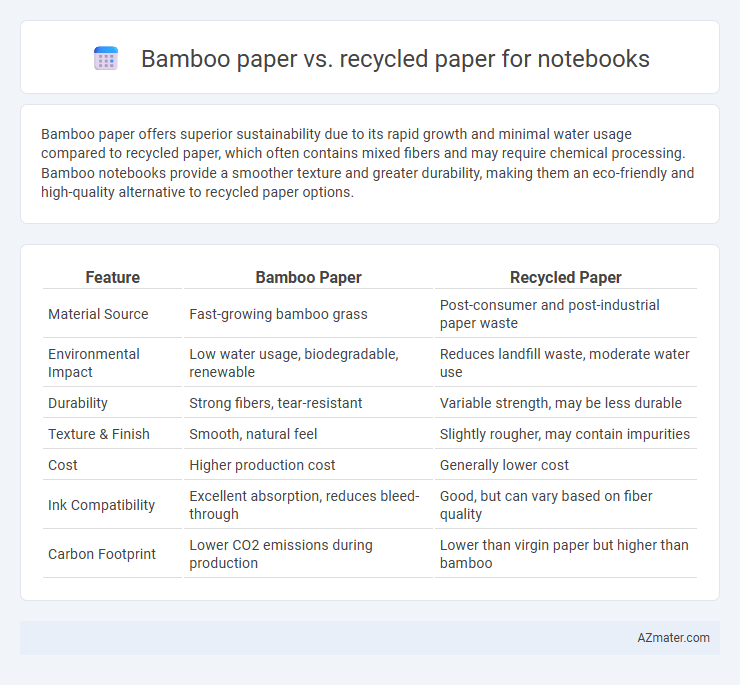Bamboo paper offers superior sustainability due to its rapid growth and minimal water usage compared to recycled paper, which often contains mixed fibers and may require chemical processing. Bamboo notebooks provide a smoother texture and greater durability, making them an eco-friendly and high-quality alternative to recycled paper options.
Table of Comparison
| Feature | Bamboo Paper | Recycled Paper |
|---|---|---|
| Material Source | Fast-growing bamboo grass | Post-consumer and post-industrial paper waste |
| Environmental Impact | Low water usage, biodegradable, renewable | Reduces landfill waste, moderate water use |
| Durability | Strong fibers, tear-resistant | Variable strength, may be less durable |
| Texture & Finish | Smooth, natural feel | Slightly rougher, may contain impurities |
| Cost | Higher production cost | Generally lower cost |
| Ink Compatibility | Excellent absorption, reduces bleed-through | Good, but can vary based on fiber quality |
| Carbon Footprint | Lower CO2 emissions during production | Lower than virgin paper but higher than bamboo |
Introduction: The Rise of Sustainable Notebook Options
Bamboo paper offers a sustainable alternative to traditional paper with its rapid growth cycle and minimal need for fertilizers, making it an eco-friendly choice for notebooks. Recycled paper reduces waste by repurposing used paper fibers, conserving natural resources and lowering carbon emissions during production. Both materials contribute to the growing market of environmentally responsible notebook options catering to eco-conscious consumers.
What is Bamboo Paper?
Bamboo paper, made from bamboo pulp, offers a sustainable alternative to traditional paper by utilizing fast-growing bamboo plants that require less water and no pesticides. Its fibers create a durable, smooth surface ideal for notebooks, often resulting in a softer texture compared to recycled paper, which is made from repurposed wood fibers. Bamboo paper's eco-friendly production reduces deforestation and carbon emissions, making it an environmentally conscious choice for notebook manufacturing.
What is Recycled Paper?
Recycled paper is made from post-consumer or post-industrial waste that has been reprocessed and transformed into new paper products, reducing the demand for virgin wood pulp and minimizing environmental impact. It typically includes collected used paper such as office paper, newspapers, and cardboard, cleaned and pulped to create eco-friendly notebook pages. Using recycled paper in notebooks supports waste reduction, conserves natural resources, and lowers greenhouse gas emissions compared to traditional paper production.
Production Process Comparison
Bamboo paper production involves rapidly renewable bamboo fibers, which grow faster and require less water and pesticides compared to traditional wood sources used in recycled paper. Recycled paper manufacturing relies on reclaiming post-consumer waste, minimizing deforestation but involving energy-intensive deinking and pulping processes that may still use chemicals. The bamboo process generally results in lower carbon emissions and reduced environmental impact due to its sustainable cultivation and less chemical usage during pulping.
Environmental Impact: Bamboo vs Recycled Paper
Bamboo paper offers a sustainable alternative to traditional recycled paper due to bamboo's rapid growth rate, requiring less water and pesticides, and its ability to absorb more carbon dioxide during cultivation. Recycled paper reduces the demand for virgin pulp, minimizing landfill waste and saving trees, but its processing often involves energy-intensive cleaning and deinking. Choosing bamboo paper over recycled paper for notebooks ultimately supports lower carbon emissions and promotes responsible resource management in the paper industry.
Durability and Quality Assessment
Bamboo paper demonstrates superior durability compared to recycled paper, offering a smoother texture and higher tensile strength that resists tearing and wear over time. Its natural fibers create a denser, more resilient surface, making it ideal for daily notebook use and long-lasting archival purposes. In contrast, recycled paper often contains shorter fibers that result in lower durability and a rougher texture, potentially compromising overall writing quality and lifespan.
Writing Experience: Texture and Performance
Bamboo paper offers a smooth, durable texture that enhances pen glide and reduces ink bleed, making it ideal for precise writing and sketching. Recycled paper often has a coarser surface with visible fibers, which can impact ink absorption and result in less consistent pen performance. Choosing bamboo paper typically provides a superior tactile feel and cleaner writing experience compared to recycled paper notebooks.
Price and Availability
Bamboo paper typically costs more than recycled paper due to its sustainable harvesting and processing methods, but it offers greater durability and smoothness. Recycled paper notebooks are generally more affordable and widely available, as they use post-consumer waste and are produced in larger quantities. Availability of bamboo paper can be limited depending on the region, while recycled paper notebooks are commonly stocked by most retailers worldwide.
Which Is More Eco-Friendly?
Bamboo paper stands out as more eco-friendly than recycled paper due to bamboo's rapid growth rate and minimal resource requirements, enabling sustainable harvesting without deforestation. Unlike recycled paper, which relies on used paper fibers and often involves energy-intensive deinking and processing, bamboo paper uses fresh fibers that are biodegradable and produce less chemical waste during manufacturing. Bamboo's carbon sequestration capacity and soil preservation capabilities further enhance its environmental benefits compared to recycled paper notebooks.
Choosing the Best Sustainable Paper for Notebooks
Bamboo paper offers superior sustainability due to its rapid growth rate and minimal water usage compared to traditional recycled paper, making it an eco-friendly choice for notebooks. Recycled paper reduces waste by reusing fibers but often requires more chemical processing, which can impact its environmental footprint. Selecting the best sustainable paper hinges on evaluating factors like carbon emissions, durability, and resource consumption, with bamboo paper emerging as a preferred option for environmentally conscious notebook production.

Infographic: Bamboo paper vs Recycled paper for Notebook
 azmater.com
azmater.com